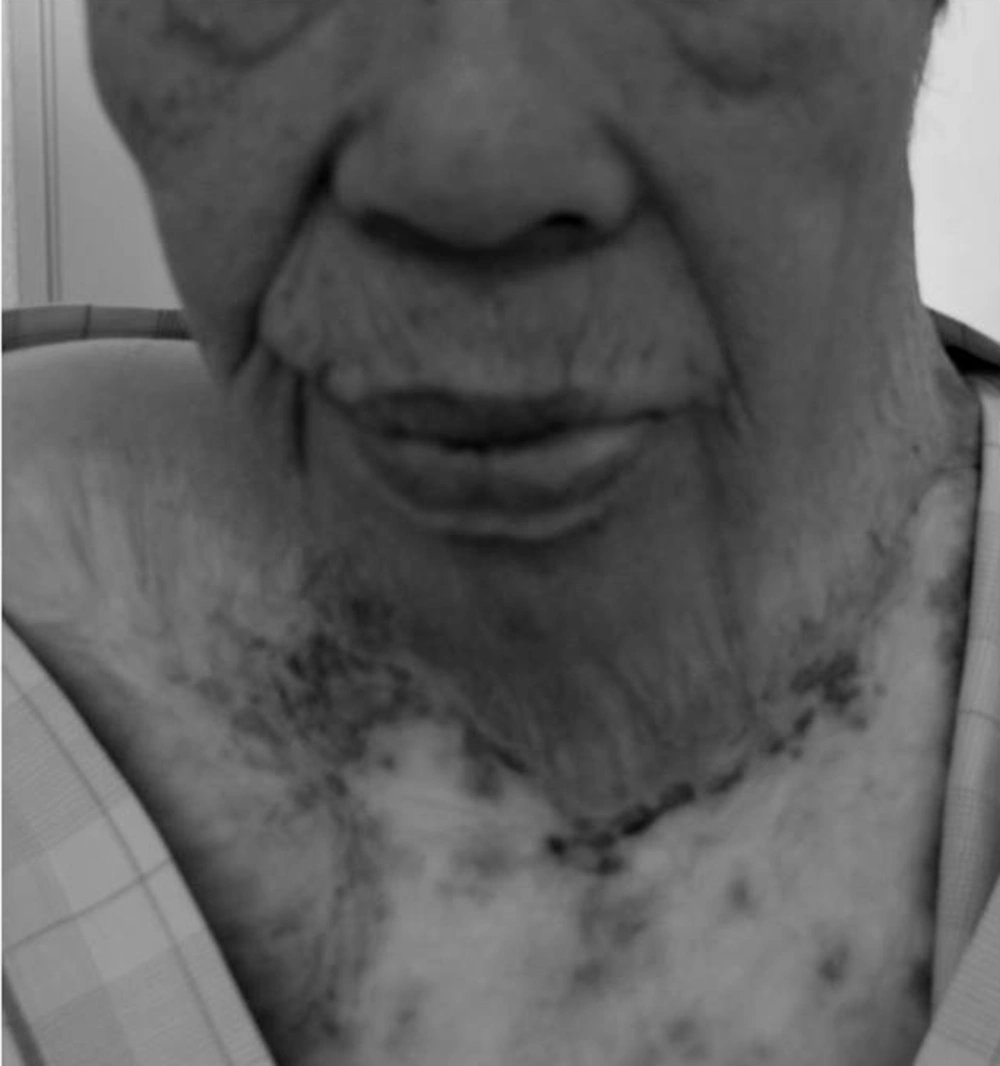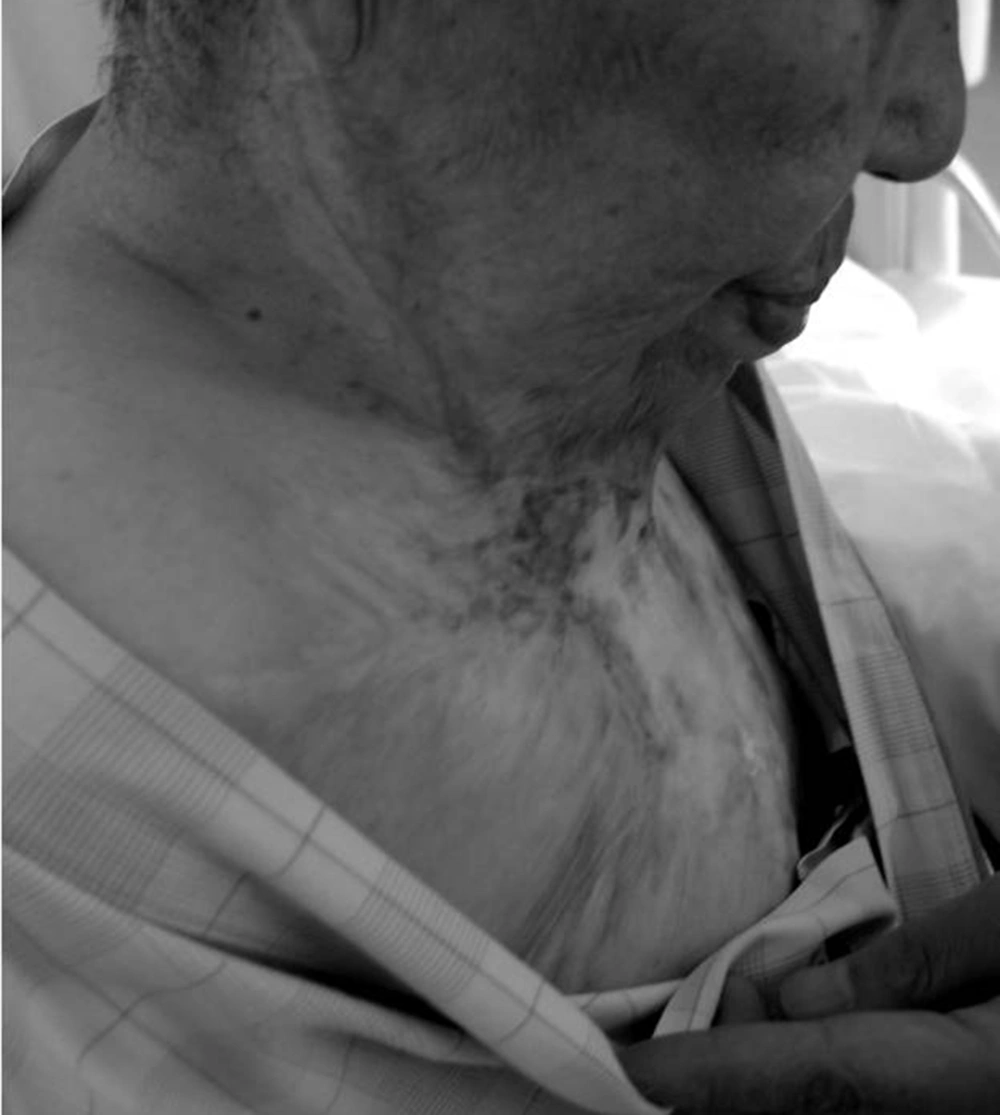1. Introduction
Securing the airway is crucial for the management of general anesthesia especially in patients with burn-induced contracture, since burn-induced cervico-mento-sternal contracture poses considerable difficulty in airway management because of the functional and anatomical distortion such as limitation of neck extension and flexion (1, 2). Lateral position decreases collapsibility of the passive pharyngeal airway in anesthetized patients (3). Moreover, the lateral decubitus position provides easy airway management and intubation for morbidly obese patients who limit movement of the cervical spine in the supine position (4). We present here a case of difficult airway management during inhalational induction that was successfully managed using the lateral position. To our knowledge, such a procedure has never been reported for the airway management during general anesthesia in patients with burn-induced cervico-mento-sternal scar contracture.
2. Case Presentation
A 78-year-old woman weighing 46 kg with burn-induced cervico-mento-sternal scar contracture was scheduled for laparoscopic cholecystectomy (Figure 1 and 2). Although her mouth opening was not limited, she had limited neck movements. Difficult airway management was anticipated. Because the patient was unwilling to agree to awake intubation and asked us to do our usual induction procedure if possible, she was planned for intubation of trachea after inhalational induction. We prepared a flexible fiberscopy and a laryngeal mask airway just in case of difficult airway management and intubation. We also prepared for urgent tracheostomy. She was premedicated with diazepam 5 mg an hour preoperatively, and anesthesia was induced with 100% oxygen and sevoflurane in gradually increasing concentrations from 0.5% to 6% and supplemental intravenous fentanyl 50 µg. Her airway patency deteriorated, and we tried chin lift and jaw thrust maneuvers in vain to ventilate her, showing the thoraco-abdominal asynchronous movements. Since the values of pulse oximetry gradually decreased from 99% to 75%, we placed her in the right lateral position. An anesthesiologist held a face mask with both the hands using a mask strap, and a surgeon used a breathing bag to assist her ventilation and thereby her airway patency was attained again and the value of pulse oximetry increased to 99%. Since laryngoscopy revealed a Grade 2 view (Cormack-lehane grading), the trachea was intubated easily after spraying 3 mL 4% lidocaine onto the oropharynx, epiglottis, and trachea in the supine position. The remainder of the anesthesia management was uneventful.
3. Discussion
Difficult airway management is a challenge to anesthesiologists. Burn-induced neck and chest contractures restrict head and neck mobility (1, 2), thereby making holding a face mask and chin lift and jaw thrust maneuvers very difficult.
In anesthetized patients, maneuvers such as chin lift and jaw thrust improve airway patency and ventilation (5). The lateral position per se decreased collapsibility of the passive pharyngeal airway in not only sleeping but also anesthetized patients with obstructive sleep apnea (3, 6-8). Also, the lateral decubitus position provides easy airway management and intubation for morbidly obese patients who limit movement of the cervical spine and atlanto-occipital flexion (4). Furthermore, the lateral position enhances the effects of chin lift and jaw thrust (6, 7).
As shown in this case report, although we tried chin lift and jaw thrust maneuvers to ventilate the patient, she showed the thoraco-abdominal asynchronous movements. However, the right lateral position dramatically attained her airway patency. The bag-mask ventilation was difficult in the supine position while the ventilation and intubation were easy in the lateral position, so we postulated that the lateral position decreased collapsibility of the passive pharyngeal airway in the present case. We therefore recommended that when you encounter difficult airway management in patients with burn-induced cervical contracture, the lateral position would be an option for airway management. Also, we have to keep it in mind that meticulous planning for anesthesia, such as fiberoptic bronchoscopy, laryngeal-mask airway, and tracheostomy, is essential to avoid catastrophic outcomes.

